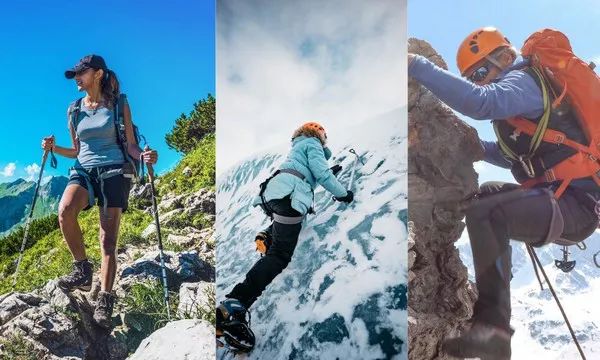Exploring the great outdoors offers a plethora of opportunities for adventure seekers. Among the myriad of outdoor activities available, hiking and mountaineering stand out as popular choices. While both involve traversing natural landscapes, they are distinct in several aspects, including terrain, skill requirements, and objectives. Understanding the disparities between hiking and mountaineering is crucial for enthusiasts to choose the activity that aligns best with their preferences and abilities.
Terrain and Environment
One of the primary distinctions between hiking and mountaineering lies in the terrain and environment in which each activity takes place. Hiking typically involves walking on established trails or paths through varied landscapes such as forests, meadows, and foothills. The trails may range from easy, well-marked paths suitable for beginners to more challenging routes that require stamina and endurance. Hiking trails are often accessible to a wide range of individuals, including families, casual adventurers, and seasoned outdoor enthusiasts.
In contrast, mountaineering ventures into more rugged and remote terrain, often characterized by steep slopes, glaciers, and high altitudes. Mountaineers frequently navigate through rocky terrain, snowfields, and icy crevasses, facing hazards such as avalanches and altitude sickness. Unlike hiking, which may involve day trips or overnight excursions, mountaineering expeditions often span several days or weeks, requiring careful planning and preparation.
Skill and Experience Requirements
Another key difference between hiking and mountaineering is the level of skill and experience required to undertake each activity safely. Hiking, particularly on well-maintained trails, generally demands minimal technical expertise. While a basic level of fitness and outdoor knowledge is beneficial, beginners can often enjoy hiking with little prior experience. Hiking trails are typically graded based on difficulty, allowing individuals to choose routes that match their abilities and comfort levels.
Mountaineering, on the other hand, demands a higher degree of technical skill, physical fitness, and mountaineering-specific knowledge. Climbers must be proficient in using specialized equipment such as ropes, harnesses, crampons, and ice axes to navigate challenging terrain safely. Additionally, an understanding of route-finding, glacier travel, and basic rope techniques is essential for negotiating steep slopes and overcoming obstacles encountered in mountainous environments. Mountaineers often undergo formal training and gain experience through progressively more difficult climbs before attempting advanced expeditions.
Objectives and Challenges
While both hiking and mountaineering offer opportunities for outdoor exploration and adventure, they differ in their objectives and the challenges they present. Hiking is often viewed as a recreational activity focused on enjoying nature, improving physical fitness, and experiencing the outdoors at a leisurely pace. Hikers may seek solitude and tranquility amidst scenic landscapes or pursue specific goals such as reaching a summit or completing a long-distance trail.
Mountaineering, by contrast, is characterized by the pursuit of climbing specific peaks or mountain ranges, often with the goal of reaching high-altitude summits. The challenges faced in mountaineering extend beyond physical exertion to include technical proficiency, risk management, and adaptation to extreme environmental conditions. Climbers may contend with unpredictable weather, altitude-induced fatigue, and logistical complexities while striving to achieve their climbing objectives.
Safety Considerations
Safety considerations play a paramount role in both hiking and mountaineering, but the nature of risks differs significantly between the two activities. Hiking, especially on well-marked trails in familiar terrain, carries relatively low inherent risks compared to mountaineering. However, hikers still need to be prepared for potential hazards such as inclement weather, wildlife encounters, and accidents resulting from slips or falls.
Mountaineering, on the other hand, presents a higher level of inherent risk due to the technical challenges and remote environments involved. Hazards such as rockfall, crevasse falls, avalanches, and altitude-related illnesses pose serious threats to climbers’ safety. Consequently, mountaineers must prioritize risk management, proper equipment usage, and adherence to safety protocols to mitigate these dangers effectively.
Conclusion
In summary, while hiking and mountaineering share a common foundation of outdoor exploration and adventure, they diverge in terms of terrain, skill requirements, objectives, and safety considerations. Hiking offers a accessible entry point to outdoor recreation, suitable for individuals of varying fitness levels and experience. In contrast, mountaineering presents a more demanding and technical pursuit, requiring specialized skills, physical conditioning, and a commitment to safety. Whether one chooses to embark on a leisurely hike through scenic trails or challenge themselves with the ascent of towering peaks, both activities offer unique opportunities to connect with nature, test personal limits, and experience the thrill of outdoor adventure. Ultimately, the choice between hiking and mountaineering depends on individual preferences, goals, and readiness to embrace the challenges of each pursuit.

